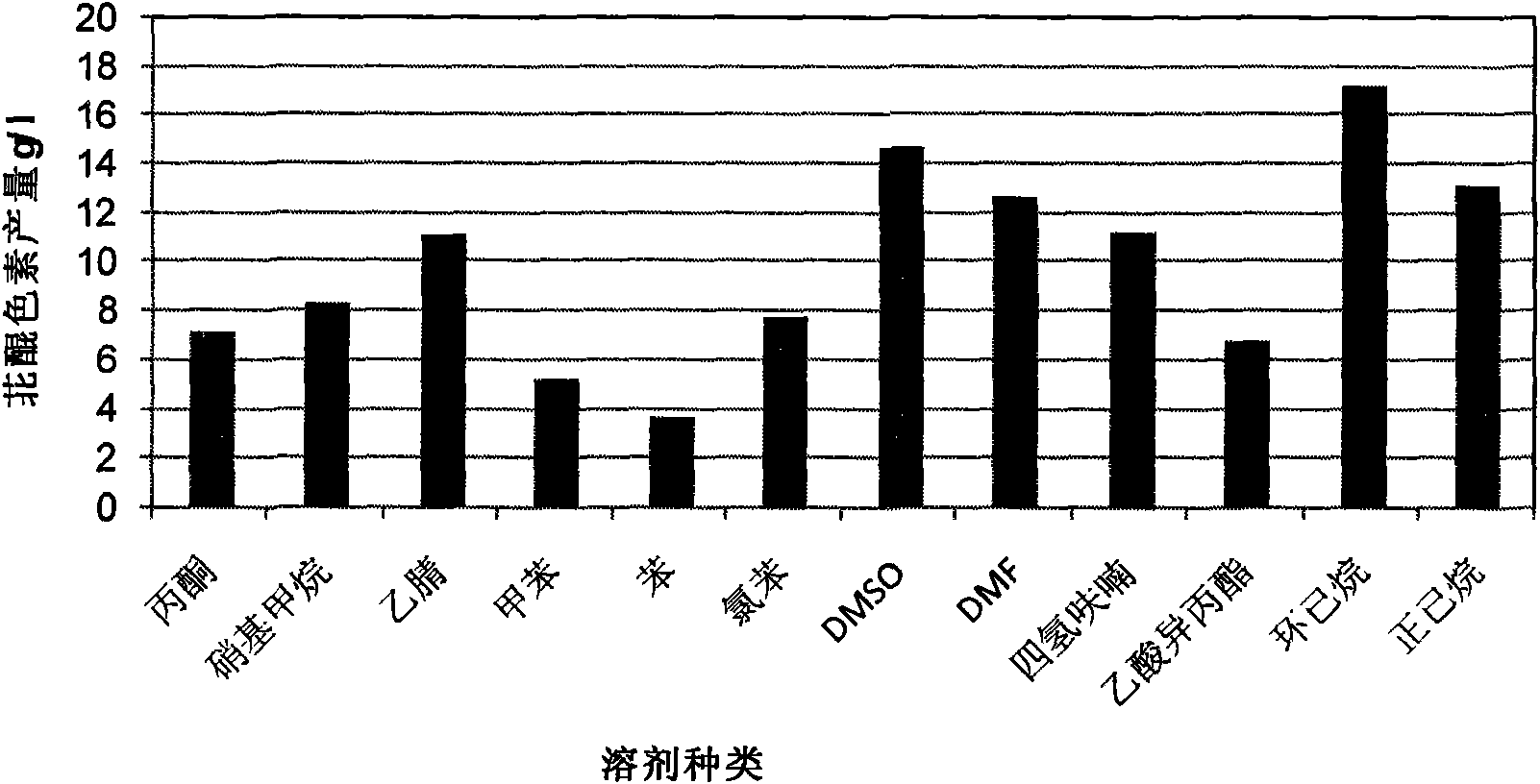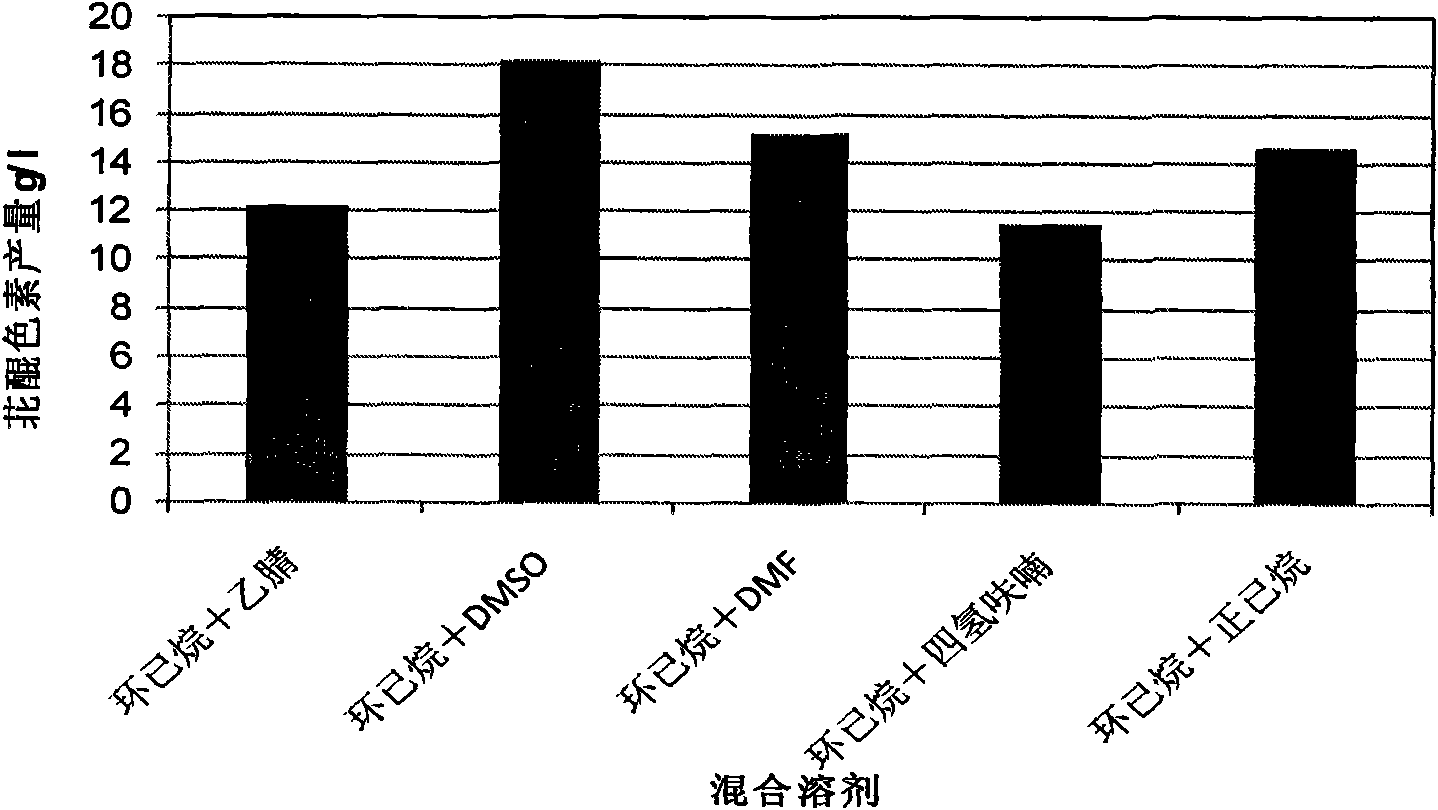Method for preparing perylenequinone pigment under catalysis of Shiraia bambusicola
A technology for catalyzing preparation and bamboo yellow fungus is applied in the field of bioengineering, and can solve the problems of undeveloped research, inability to apply industrialized production, and low yield of perylene quinone pigments.
- Summary
- Abstract
- Description
- Claims
- Application Information
AI Technical Summary
Problems solved by technology
Method used
Image
Examples
Embodiment 1
[0053] Liquid culture of bamboo yellow bacteria, the medium composition is: glucose 40g / L, yeast extract 2g / L, diammonium hydrogen phosphate 2g / L, potassium dihydrogen phosphate 1g / L, magnesium sulfate 0.5g / L, 300L air lift type The fermenter has a liquid filling capacity of 70%, a ventilation rate of 1:1.5 v / v / m, a culture time of 56 hours, and about 220 g of wet thalli can be obtained per liter of fermented liquid. Cells were treated as previously described. Put the treated cells into the reaction system, the reaction mixture contains 60g / L cell suspension, 5g / L cinnamic acid, and 50mM potassium phosphate buffer (pH7.0). The reaction started after adding the cell suspension, and the reaction was stirred at 30° C. for 6 h. The total perylenequinone pigment in the final reaction body is 2g / L, and the bacterial cells in the initial stage of the reaction contain 0.2g / L of perylenequinone pigment, and the calculated conversion rate is 9.7%. Among them, hypocrellin A accounts fo...
Embodiment 2
[0055] Somatic cells of bamboo yellow bacteria are cultured in liquid state, and the medium composition is: sucrose 40g / L, yeast extract 2g / L, diammonium hydrogen phosphate 2g / L, potassium dihydrogen phosphate 1g / L, magnesium sulfate 0.5g / L. At the initial stage of fermentation, 3 g / L of cinnamic acid was added at one time. 500L mechanical agitation fermenter, ventilation rate 1:0.4v / v / m, stirring speed 150r / min, cultivation time 72 hours, about 191g of wet bacteria can be obtained per liter of fermentation broth. Under this condition, the yield of perylenequinone pigment in the fermentation broth can reach 1.5g / L. Among them, hypocrellin A accounts for 91% of the total pigment amount, and hypocrellin B is 5%. As a control, 0.8 g / L of perylenequinone pigment could be produced without adding cinnamic acid under the same fermentation conditions. The conversion was therefore calculated to be 6.3%.
Embodiment 3
[0057] Liquid culture bacterial cells (strain SUPER-H168): fructose 40g / L, peptone 2g / L, corn steep liquor powder 20g / L, diammonium hydrogen phosphate 2g / L, potassium dihydrogen phosphate 1g / L, magnesium sulfate 0.5g / L L, compound A5g / L, pH6.0. 300L air-lift fermenter, liquid volume 70%, ventilation rate 1: 1.5v / v / m, culture time 72h, fresh bacteria can be obtained per liter of fermentation broth about 231g. Under this condition, the yield of perylenequinone pigment can reach 2.9g / L. Among them, hypocrellin A accounts for 90% of the total pigment amount, and hypocrellin B is 6%. As a control, 0.6 g / L of perylenequinone pigment could be produced without compound A under the same fermentation conditions. The conversion was therefore calculated to be 26.3%. Compound A:
[0058]
PUM
 Login to View More
Login to View More Abstract
Description
Claims
Application Information
 Login to View More
Login to View More - R&D
- Intellectual Property
- Life Sciences
- Materials
- Tech Scout
- Unparalleled Data Quality
- Higher Quality Content
- 60% Fewer Hallucinations
Browse by: Latest US Patents, China's latest patents, Technical Efficacy Thesaurus, Application Domain, Technology Topic, Popular Technical Reports.
© 2025 PatSnap. All rights reserved.Legal|Privacy policy|Modern Slavery Act Transparency Statement|Sitemap|About US| Contact US: help@patsnap.com



